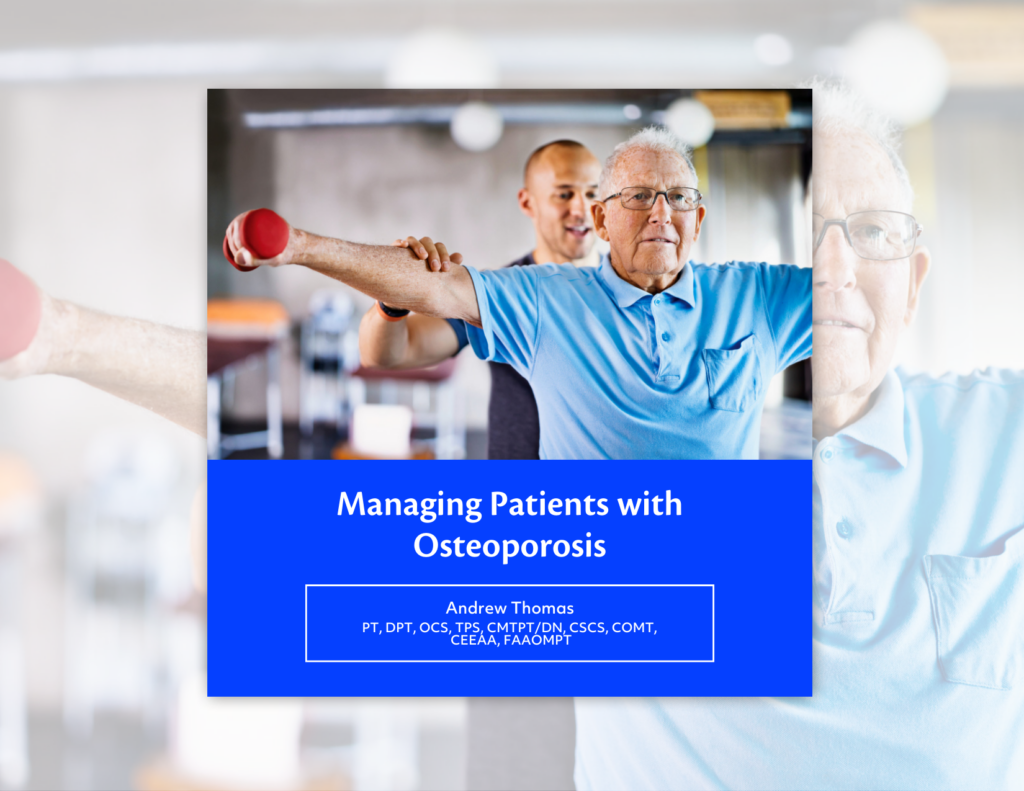
Treating patients who have osteoporosis can be challenging for both novice and experienced clinicians. Much of this challenge comes from the bias of entry-DPT programs where educational curriculum is often limited to general pathology, co-morbid fracture risk, and contradictions for flexion movement patterns. Little is covered regarding what these individuals can do versus what they should not do. Due to this negative language, improper beliefs and fear are often instilled in these clinicians, resulting in suboptimal outcomes for these patients including inappropriate exercise dosing and poor utilization of other interventions such as manual therapy due to fear of fracture. There is, however, research out there to support more aggressive manual therapy techniques and exercise intervention for these patients that is proven to be both effective, and safe. With a population that is continuing to age, and the average age increasing of patients that are presenting to therapy, it is important that clinicians understand how to best treat these patients and to put aside any biases or fears with appropriate screening techniques.
Osteoporosis is defined as a reduction in bone mass and disruption of the bone architecture, which leads to decreased bone strength, and increase fracture. Traditionally diagnosed through a Dual Energy X-Ray Absorptiometry scan (DEXA) scan. A T-score related to bone density compared to normal 30-year old’s is provided. Those with ≤ 2.5 at the lumbar spine or hip are given the diagnosis of osteoporosis. From 2005-2010, 16.2% of adults aged 65 and older had osteoporosis at the lumbar spine or femoral neck with women being more likely affected1.
Newer research that has come out regarding the treatment of patients who have the diagnosis of osteoporosis is helping give therapists support for more aggressive techniques. Manual therapy techniques including mobilization and manipulation have been shown to be beneficial for the treatment of osteoporotic vertebral fracture and in the attenuation of thoracic kyphosis in older adult patients2,3. With regards to exercise training, a recent study demonstrated that performing high-intensity, progressive resistance and impact weight-bearing training activities was superior for bone mass, femoral neck geometry, and physical function compared with a low intensity home exercise program in older adult females with the diagnosis of osteoporosis4. The group that performed these exercises had no fractures or major adverse effects. These studies help to prove that we should be more aggressive in the application of our manual therapy techniques and exercise prescription in patients with osteoporosis.
Bringing the most up to date evidence-informed practice to our patients to help improve their function and decrease risk for adverse complications due to osteoporosis is something that we should be looking to do on a daily basis. The research is constantly evolving, and the clinicians need to evolve with it. The Evidence in Motion webinar that I am hosting on April 19, 2023 will address screening, physical assessment, and evidence-informed interventional processes to meet the needs of this population.
To learn more about Managing Patients with Osteoporosis please Join us for the FREE Webinar Event, that will be hosted by Andrew Thomas on April 19th at 7:30 p.m. CT, Register Now!
- References
- Looker AC, Frenk SM. Percentage of adults aged 65 and over with osteoporosis or low bone mass at the femur neck or lumbar spine: United States, 2005–2010. National Center for Health Statistics. 2015. https://www.cdc.gov/nchs/data/hestat/osteoporsis/osteoporosis2005_2010.pdf.
- Bennell KL, Matthews B, Greig A, et al. Effects of an exercise and manual therapy program on physical impairments, function and quality-of-life in people with osteoporotic vertebral fracture: a randomised, single-blind controlled pilot trial. BMC Musculoskelet Disord. 2010;11(1):36.
- Bautmans I, Van Arken J, Van Mackelenberg M, Mets T. Rehabilitation using manual mobilization for thoracic kyphosis in elderly postmenopausal patients with osteoporosis. J Rehabil Med. 2010;42(2):129-135.
- Watson S, Weeks B, Weis L, Harding A, Horan S, Beck B. High-Intensity Resistance and Impact Training Improves Bone Mineral Density and Physical Function in Postmenopausal Women With Osteopenia and Osteoporosis: The LIFTMOR Randomized Controlled Trial. J Bone Miner Res. 2019;34(3):572-572.
